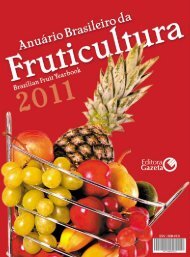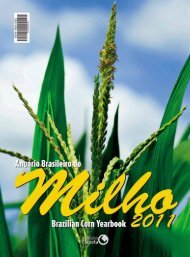tradicionalmenteinovador - Brazil Buyers & Sellers
tradicionalmenteinovador - Brazil Buyers & Sellers
tradicionalmenteinovador - Brazil Buyers & Sellers
Create successful ePaper yourself
Turn your PDF publications into a flip-book with our unique Google optimized e-Paper software.
The segment of vegetables, in view<br />
of the production challenges posed by<br />
demand, has been coming up with new<br />
alternatives to attract new consumers.<br />
Besides attempting to make strides on the<br />
industrial side, the segment has embarked<br />
on the minimally processed horticultural<br />
products, that is to say, physically modified,<br />
but kept in their fresh state. Bound to<br />
a similar direction, but specifically focused<br />
on size reductions, the so-called mini vegetables<br />
are now steadily making it to the<br />
market, and so are baby vegetables, and<br />
they enjoy great popularity and are highly<br />
valued by consumers that go in for easy<br />
to use items.<br />
The mini vegetables are created<br />
through genetic enhancement programs<br />
and their seed, in most cases is<br />
hybrid and imported, while baby vegetables<br />
result from crop management<br />
practices, like anticipated harvest and,<br />
in the case of young leaves, they are<br />
known as baby leaf. The explanation<br />
is given by Luis Felipe Villani Purquerio,<br />
of the Center for Horticulture run by<br />
the Agronomic Institute of Campinas,<br />
and Paulo César Tavares de Melo, of<br />
the Vegetable Production Department<br />
controlled by the well known Luiz de<br />
Queiroz College of Agriculture, linked<br />
with the University of (Esalq/USP).<br />
Among the miniaturized products,<br />
besides the minimally processed and<br />
smaller in size, like the mini-carrots, the<br />
best known is the cherry tomato. Other<br />
horticultural products that enjoy the<br />
same status include pumpkin, lettuce,<br />
eggplant, chayote, cauliflower, cucumber,<br />
pepper and watermelon, and<br />
others. The cherry tomato also comes<br />
in another version known as grape tomato,<br />
with a shape similar to a grape<br />
berry, deep red color and a very sweet<br />
taste. It is selling briskly, although a box<br />
of 180-grams sells for R$ 3. Likewise, the<br />
mini watermelon, weighing from two to<br />
three kilos, seedless, deep green, fetches<br />
up to six times higher prices than traditional<br />
watermelons. Baby leaves also<br />
sell for high prices, sometimes fetching<br />
R$ 5 per 120-gram box of lettuce,<br />
NOVELTIES OFFER<br />
PRACTICALITY, BUT<br />
WEIGH HEAVY ON<br />
THE POCKET<br />
watercress, beet, mizuna cabbage and<br />
wakame mustard. This combination<br />
imparts a high nutritional value to the<br />
product, Purquerio and Melo confirm.<br />
What characterizes the baby leaf is<br />
practicality, with a packaged product,<br />
sanitized and ready to consume.<br />
Specialists of the sector envision in<br />
these market niches a potential for expansion,<br />
since the number of childless<br />
couples and people living alone is on<br />
the rise in big centers, and they all seek<br />
options. For the productive sector, it<br />
translates into a chance for expanding<br />
their vegetable cultivations and, for the<br />
technical-scientific sector, it represents<br />
new requirements for further studies<br />
and the generation of knowledge for<br />
developing the sector.





